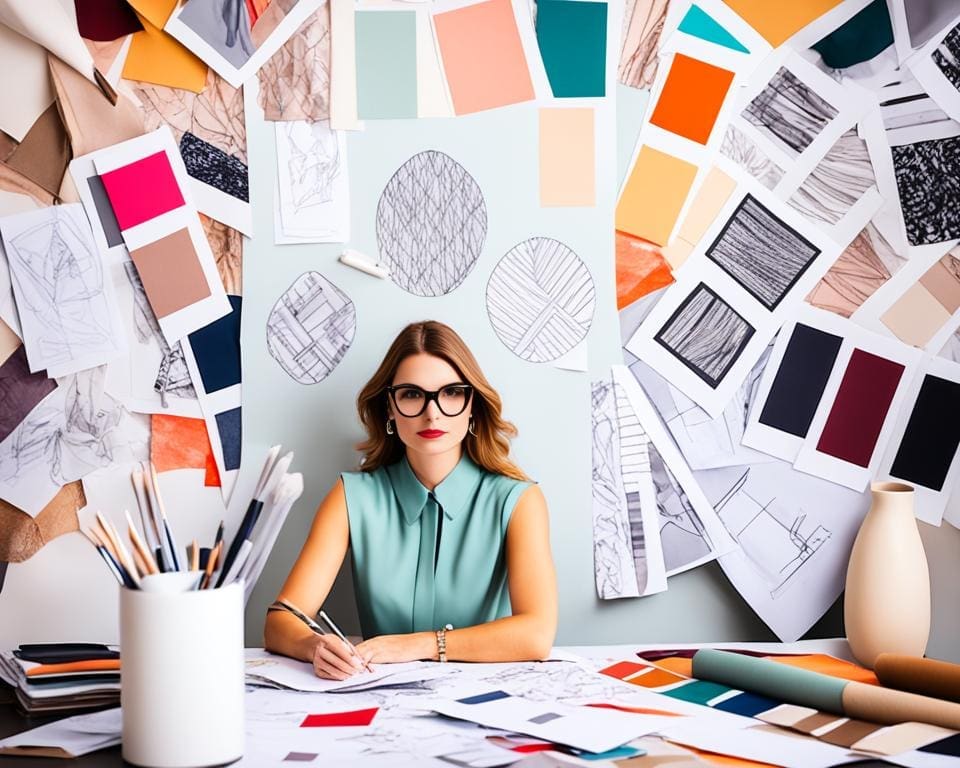Fashion design goes beyond a mere job. It’s the art of turning dreams into the clothes we wear. Designers blend present trends with timeless elegance. They make collections that show off their creative vision.
This journey starts with combining art and practicality. Designers aim to resonate with consumers while keeping up with fashion’s fast pace. In this colorful world, collections are usually aligned with the seasons. This helps plan releases and meet the buyers’ expectations.
The Role of Inspiration in Fashion Design
Inspiration is crucial in fashion design. It starts the creative journey, leading to new collections. Designers draw on art, nature, culture, and history for ideas. These sources feed their creativity, sparking fresh design ideas.
Sources of Creative Inspiration
- Nature – The natural world’s beauty inspires unique design themes.
- Artistic Movements – Art evokes feelings and ideas that flow into fashion.
- Nostalgia – Vintage styles encourage designers to revive past trends.
- Culture – World cultures provide a vast array of design ideas.
- Personal Experiences – Life’s emotions can lead to unforgettable fashion collections.
Documenting and Storing Ideas
It’s key to record ideas when inspiration hits. Designers build an “inspiration bank” for this purpose. They use sketchbooks or digital tools like Pinterest to hold ideas. This way, they keep concepts alive until they’re turned into fashion pieces.
Integrating Inspiration into Design Concepts
The final step is turning ideas into actual designs. Designers think about texture, colours, and shapes. They mix inspiration with skill to make clothes that appeal to many. This helps them stand out in the fast-paced fashion world.

Fashion Design: The Art of Creating a Collection
Making a fashion collection is about knowing Fashion Seasons and trends. Designers plan their releases with the market in mind. This ensures their designs meet what shoppers expect for each season.
Understanding Fashion Seasons and Trends
The idea of Fashion Seasons splits into spring/summer and autumn/winter. Each season has its own style, colours, and materials. Knowing these changes helps designers create excitement for new launches. It makes their collections more appealing.
Building a Cohesive Collection Narrative
For a designer, having a cohesive story in a collection is crucial. Every item should both stand out and work well with others. This unity is made by thinking about colours, textures, and styles together. A narrative lets people see whole outfits, not just single pieces.
The Impact of Trend Forecasting on Collection Planning
Trend Forecasting is vital in planning a collection. It gives a peek into what people might want and future market trends. Designers look at past trends and what people like. This helps them match their collections to changing tastes. Being adaptable makes a collection more likely to succeed. It improves marketing and connects better with shoppers.
The Technical Aspects of Collection Creation
Bringing a fashion collection to life involves a deep understanding of technical skills. It’s about turning creative ideas into real pieces through careful work. Skills like pattern making, sewing, and draping are key. They are needed not just to make clothes look good. They also ensure clothes are strong and serve their purpose well.
Garment Construction Techniques
Fashion design centers on the detailed art of making clothes. It’s more than putting pieces together. It’s about making everything fit perfectly in the collection’s story. Designers look up to icons like Charles Fréderik Worth, who led the way for future designers. The choice of fabric and how to finish a piece are crucial. They help make the end product look professional and high-quality.
Textile Design and Innovation
Textile design today is full of new ideas. Designers are choosing materials that are better for the planet, like organic or recycled fabrics. They’re using digital tools to quickly try out new designs. This makes the creative process even better. Working to be eco-friendly shows they care about the planet. It’s a big part of being in fashion today.
Creating Patterns and Prototyping Designs
Moving from an idea to a real product ends with making patterns and prototypes. This careful step lets designers test and tweak designs. They start with samples in cheaper fabrics. This is essential for making the final clothes exactly right. This way, the collection stays true to the designer’s original idea and the brand’s identity.









